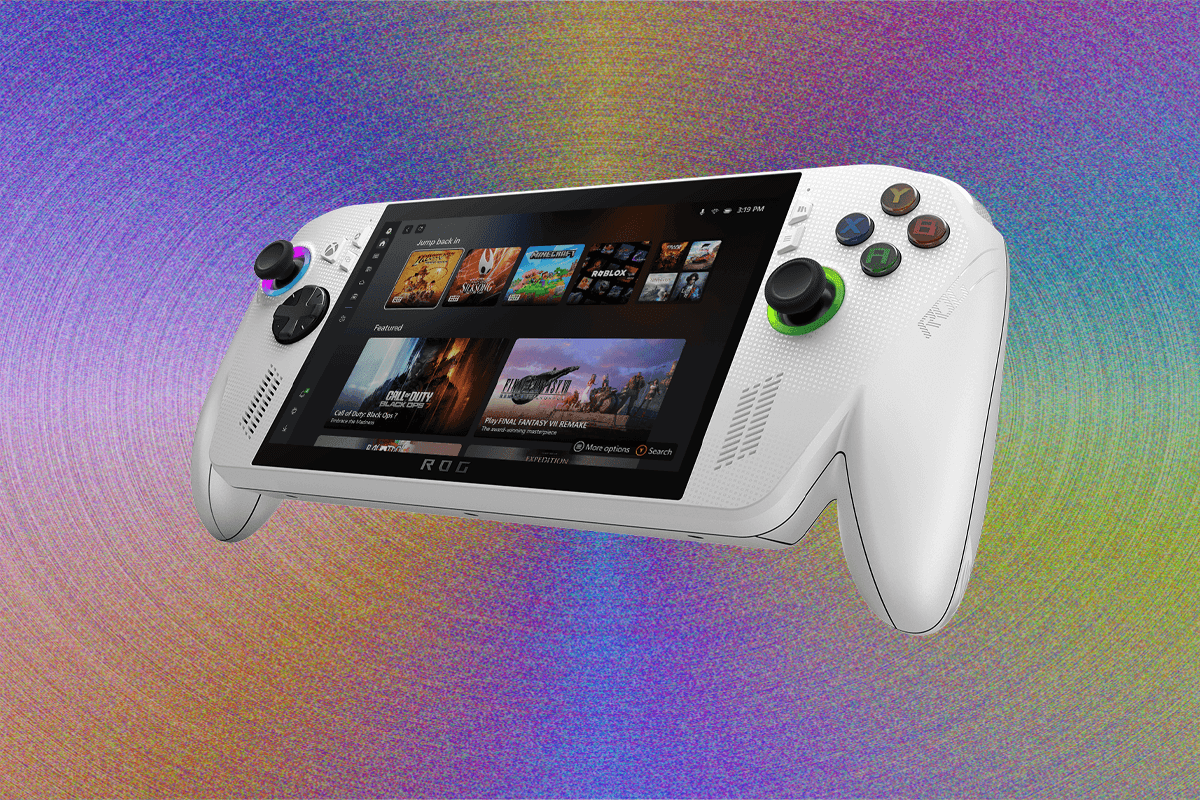A handheld Xbox has been rumored since at least the Xbox 360 era, where gaming forums were rife with speculation that Microsoft was about to face off against Nintendo’s DS and Sony’s PSP. If there was ever anything to the rumor, nothing came of it—until now, 20-odd years later, with Xbox’s first genuine foray into portable gaming.
The Redmond giant isn’t diving in solo, though—rather than its own dedicated device, Microsoft has partnered with Asus to deliver two distinct units, the entry-grade ROG Xbox Ally at $600, and the more powerful ROG Xbox Ally X at a somewhat staggering $1,000. These aren’t so much Xbox handhelds as Xbox-branded handhelds, though, adding recognizable iconography onto what might otherwise be the next generation of Asus’ own portables. The team-up delivers top-tier portable play—but a frequently confusing experience.
A What Box?
It’s best to start with what the X-ROGs—not official terminology, but good shorthand for the pair—aren’t. They’re not Microsoft’s answer to the Nintendo Switch 2, a bespoke console letting you seamlessly enjoy home-quality gaming on the go. Nor are they a take on the Steam Deck, a portable built around the Xbox ecosystem rather than your Steam library. Despite sporting the same signature “X” icon button as on an Xbox controller, these are handheld gaming PCs in Xbox drag, with all the good and bad that entails.
.png)
Photograph: Matt Kamen
Both X-ROGs run a full version of Windows 11, with the Xbox app for PC’s new “full screen experience” as the default user interface. Because these are PCs at heart, though, even if you’re using the same Xbox account as on your Xbox Series X or Series S, your game library on the X-ROGs will only show titles included in the Xbox Play Anywhere program. Since you can only figure out what’s not available by their absence, you may find a game you fancied playing on the go isn’t an option. Along with the difference in how the library is sorted and filtered, it’s not the smoothest transition for console players.
The overall UI also feels more cluttered than a handheld should, with a home screen that shows your recently played games above a bunch of “Featured” offers, a row of titles recently added to Game Pass, and more. It’s a far cry from the stark, minimalist elegance of the Switch 2, highlighting how much is left to be desired in optimizing the Xbox for the handheld form.
Unfortunately, Microsoft is also crow-barring AI features in, with a new Gaming Copilot assistant (also coming to the desktop PC Xbox app). It’s pitched as “your personal gaming sidekick,” recognizing what’s happening onscreen and responding to voice inquiries for help on parts you’re stuck on. It speaks in one of four “personalities,” including a cringey “heroic”—it’s detestable, but thankfully optional, so I quickly deactivated.
Win Some, Lose Some
Running Windows under the Xbox hood also means frustrations when it comes to software updates—is it just the Xbox app that needs an update or the whole system? Should you go through the Windows App store or the Windows Update tool? Will a future system update break your games? It’s all a lot more convoluted than simply turning a console on and playing a game. And, while you can swap to a full Windows desktop view at any time—and even connect a mouse if you don’t fancy battling through Windows’ endless menus and submenus with the X-ROGs’ thumbsticks or touchscreens—finding exactly what setting may need fiddling with when you just want to play a game can be a chore.
.png)
Photograph: Matt Kamen
However, because the X-ROGs are fundamentally regular PCs, they’re a lot more versatile than Nintendo’s or Valve’s efforts. Not only can you play media, browse, or do anything else you might do on a PC (even Office tasks, if you hate joy), but you can install any other PC gaming client—Steam, Epic, GOG, and more are all available. Better still, the Xbox app aggregates all games installed on the system into one library view, regardless of where they originate. You can even turn your ROG Xbox into an ersatz Steam Deck by running Steam in Big Picture mode (although some of its controller key bindings may not work).
The big win—pardon the pun—is that you can install mods with ease. While I’ve gotten a few mods running on my Steam Deck over the years, its Linux underbelly makes things trickier. On the X-ROGs, I’ve been able to use mods as easily as on my main gaming desktop, with no second-guessing if they’ll actually work. It’s a great feature that’s facilitated by having standard Windows as the base.
Soft Where?
But wait, there’s a third UI player in the mix: Asus’ own Armoury Crate SE software. Broadly, this is more of a device manager, with a dedicated button on both consoles to bring up a Command Center quick menu. This allows you to instantly switch power profiles, create custom control inputs, or set frame rate limits. It also offers a real-time monitor displaying useful system information like temperature, CPU and GPU performance, battery level and power drain, and the current frame rate.
However, fully open Armoury Crate and you’ll find an array of far deeper controls, from granular system settings to tweaking color profiles of the LED rings that sit under each thumbstick. It also has its own Update Center—yet another to check—and its own unified library, distinct from the Xbox app’s. After a week with the X-ROGs, I’m finally familiar with where functions live, but the learning curve is steep, and having essentially three central interfaces—Xbox, Windows, Armoury Crate—for a single device is ridiculous.
.png)
Photograph: Matt Kamen
On this at least, the X-ROGs are no different from Asus’ original ROG Ally or 2024’s ROG Ally X, or even other Windows-based gaming handhelds, such as the Lenovo Legion S Go. Hopping between multiple UIs doing variations of the same thing has become a kind of jank that feels baked into the entire product category. If you’re accustomed to that, you’ll feel right at home with the X-ROGs, with all their foibles.
However, the Xbox branding here is likely to attract players who, while perhaps more committed than “casual” gamers, still want a slick, pick-up-and-play experience from a handheld. If you stick purely to the Xbox app, the X-ROGs can be close to that, but the more you want to get out of them, the less intuitive they are.
Spot the Difference
That’s a lot to get your head around before getting started, but mercifully, it’s worth it. Both the ROG Xbox Ally and the ROG Xbox Ally X are significant improvements on Asus’ predecessors. In fact, these might be two of the best handheld gaming PCs I’ve ever used—although the use case for each ends up being quite different.
At a glance, the X-ROGs might seem separated only by colorways. The ROG Xbox Ally comes in white with multi-colored A/B/X/Y face buttons, while the ROG Xbox Ally X opts for all-black with gray buttons. Both use the same 290.8 x 121.5 x 50.7-millimeter form factor, each subtly decorated with near-microscopic “XBOX ROG” lettering cascading vertically down the shell like The Matrix code. They look and feel distinctly premium, as you’d expect given their prices.
%2520(4).png)
The Xbox ROG Ally comes in white with multi-colored face buttons, while the Xbox ROG Ally X opts for all-black with gray buttons.
Photograph: Matt Kamen
Ergonomics are superb, with angular grips feeling more like holding a conventional Xbox controller than the brick-with-a-screen of many handheld PCs. All inputs are within reach, from the traditionally asymmetrical thumbsticks to the textured shoulder buttons and satisfyingly chunky triggers. At the rear sit two macro buttons with customizable inputs. Despite being nominally heavier than a Steam Deck’s 669 grams—the Xbox ROG Ally weighs in at 670 grams, the Ally X at 715 grams—the masterful design means they sit better in the hand and are more comfortable to use for long play periods.
Both models also use the same screen, a 7-inch, 1920 x 1080p, 16:9 IPS touchscreen panel with a 120-Hz refresh rate and 500-nit brightness. Buyers will want to get a screen protector—it’s made of Gorilla Glass Victus, but given how often you’ll poke or swipe the screen to navigate the system, added protection feels necessary. When it’s not covered in finger smudges, this is a great, sharp display at its default settings, and its performance can be further tweaked in Armoury Crate, either manually or with quick-sets tailored to specific gaming genres.
However, at the prices these handhelds are coming in at, it’s hard not to feel a bit shortchanged that the screen isn’t OLED, even on the higher-priced ROG Xbox Ally X. These are essentially the same screens as on Asus’ previous ROG Ally, and despite both X-ROGs offering a higher resolution and refresh rate, the Steam Deck OLED‘s perfect black levels and ability to deliver HDR does still give it a slight edge.
Power Players
.png)
Photograph: Matt Kamen
The X-ROGs more clearly diverge in function. Some differences are small—the Ally’s triggers incorporate Hall effect tech, while the Ally X uses Microsoft’s Impulse Triggers for more nuanced haptics. Both feature two USB-C ports at the top—and you can charge through either—but the Ally’s are both USB 3.2 Gen 2 (with DisplayPort 1.4 output and Power Delivery 3.0 support), while the Ally X has one USB 4 port with Thunderbolt 4 compatibility, and one USB 3.2 Gen 2 (both with DisplayPort 2.1 out), giving more versatility.
Major distinctions come down to raw power. The Ally packs in an AMD Ryzen Z2 A processor, 16 GB LPDDR5-6400 RAM, and a 512-GB SSD—no slouch, but wildly outclassed by the Ally X. The flagship model’s Ryzen AI Z2 Extreme chip is an absolute beast, and it’s backed up by 24 GB LPDDR5X-8000 RAM and a 1-TB SSD. The resulting difference is clear to see, both in performance and who each handheld is aimed at.
Installing Forza Horizon 5 on both, the Ally impressed initially, still meeting requirements for the game’s “High” quality preset. However, the game automatically set the frame rate cap to 30 fps, while a buried setting within the Xbox app for the Ally itself (absent on the Ally X) was set to “automatically limit games to 720p” resolution. Turning that off and raising the frame rate to the 120 fps the Ally is hypothetically capable of, performance dived, resulting in slightly juddery races around Mexico. Plugging the Ally in, maxing its power profile to the 20-watt “Turbo” setting in Armoury Crate, and boosting just about every other possible metric improved things, reaching a high of 48 fps—eminently playable, but nothing amazing.
.png)
Photograph: Matt Kamen
On the Ally X, however, Forza ran at a smooth 60 fps straight away, off battery. Again, lifting the frame cap to 120 fps, even the Ally X never quite hit that magic number, but it did hover around 78 to 85 fps, while plugging in and setting the console to its 25-watt Turbo max saw it occasionally crest over 90 fps. Similar performance differentials were observed on other demanding AAA games installed on each handheld, including Gears of War: Reloaded, Avowed, and Halo Infinite—the Ally struggled while the Ally X handled everything I threw at it.
The basic Ally can shine with less technologically demanding games, though. Hollow Knight: Silksong hits a consistent 120 fps, while some retro classics and indies installed via Steam—Final Fantasy IX, Dredge, and Owlboy among them—all ran without a hitch. Much like the Steam Deck itself, the Ally feels best suited to these smaller titles, which also have the benefit of not eating up the entire SSD. Forza alone required a full quarter of the Ally’s storage, colossal install sizes being another reminder of a lack of optimization. Both X-ROGs use standard M.2 2280 factor SSDs, though, so they should be easily upgradable, and both support microSD cards too—again better for smaller, less demanding games to be installed on.
There’s one other workaround for performance throttles or storage issues, though: cloud gaming, which is surprisingly well implemented here. Testing out Bethesda’s DOOM: The Dark Ages through Xbox Cloud Gaming (other platforms such as Nvidia’s GeForce Now are also accessible), it connected quickly, played without a single drop-out, and ran at a consistent 60 fps on both X-ROGs. I don’t know what witchcraft Xbox has been doing backstage, but this is the best cloud gaming I’ve ever encountered.
Whatever and however you’re playing, battery life is impressive for both X-ROGs. Even though the Ally X again has an advantage—packing an 80-Wh battery versus the Ally’s 60-Wh—I regularly got around six hours’ play out of both units between charges, depending on the game. Playing an hour of Hollow Knight: Silksong—again, not the most demanding title—on each took the Ally from full to 85 percent, while the Ally X dropped to 88 percent. Cloud gaming saw barely any drain on either, about 7 percent per hour, but locally installed Forza or Gears slurped up around 30 to 35 percent of a full charge on both X-ROGs in around 45 minutes. Even that’s far less draining than I expected, rendering both units surprisingly viable for longer play.
Who Are These for?
.png)
Photograph: Matt Kamen
Both X-ROGs stand out in the increasingly crowded field of handheld gaming PCs, thanks to strong design, comfort of use, and cross-platform versatility that outpace most of the competition. Neither model is perfect, but for its first venture into the handheld space, Microsoft gets a lot right in its partnership with Asus.
If you want a reasonably powerful gaming PC that can run small to mid-size games with ease, and even some more demanding ones in a playable if not astounding state, the ROG Xbox Ally is a great choice—especially if you’re happy to turn to cloud gaming for the most demanding titles.
If you want uncompromising performance and high-end capabilities, though, the ROG Xbox Ally X is a clear winner. It breezes through everything the baseline Ally does, and delivers authentic AAA gaming to boot. It’s exceptional. In doing so, it’s clearly, unabashedly targeting the “hardcore” gamer—and it’s going to financially bleed them for the privilege.
Those prices are by far the biggest obstacle for either model, but if you’re able to splash out on a high-end handheld, these can take portable gaming to the next level.




